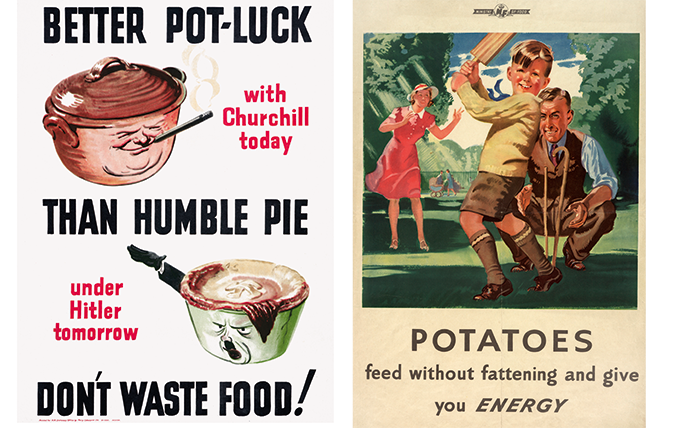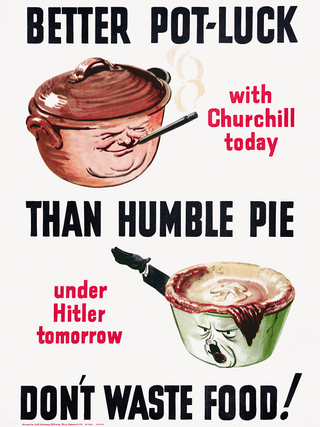Victory in the Kitchen: The recipes that kept Britain going in the Second World War
You too can rustle up something delicious out of meagre rations with these austerity recipes.


The Second World War had a huge impact on the kitchens, and the stomachs, of millions of British people.
Food was ‘a munition of war’ and without it, military forces could not fight on; civilian workers could not contribute to their nation’s ‘war machine’ in the unrelenting production of weapons and equipment; and ordinary people living through a state of war on the home fronts had to be sustained. Food was their fuel.
With imports hit hard by the attacks on shipping convoys, compromises were made to get Britain as far as possible towards self-sufficiency. Food was never wasted; alternate ingredients were constantly tried out. Those efforts have been celebrated in a new book called Victory in the Kitchen, published by the Imperial War Museum at £6.99.
Victory in the Kitchen is not your usual cookbook: there are no beautiful photographs of food carefully prepared in studios, but instead a collection of simple, delightful and – to our modern palates – unusual recipes from the Second World War. It's all beautifully illustrated with some of the museum's collection of beautiful and often very funny wartime posters.
We've picked out two of the recipes for you to try – two of the pie recipes, just like your mothers, grandmothers or great-grandmothers might have made in the war.
Lord Woolton’s Pie
For a nation that favoured meat, it was extraordinary for a vegetarian dish to be accepted by the British people. Lord Woolton’s Pie is an example of a dish that was so successful, it in fact became a legendary wartime recipe. As overseas supplies became increasingly threatened by the war, there was a push towards home-grown produce and self-sufficiency.
That need led to the creation of this pie, one of the most popular wartime recipes, which was named after the wartime Minister of Food. It's a root vegetable pie, including the infamous ‘Doctor Carrot’ and ‘Potato Pete,’ blended with oats and topped with a potato crust.
Sign up for the Country Life Newsletter
Exquisite houses, the beauty of Nature, and how to get the most from your life, straight to your inbox.
Ingredients - filling
- 1lb seasonal vegetables such as potato, swede, cauliflower and carrot
- 3–4 spring onions
- 1 teaspoon vegetable extract
- 1 tablespoon oatmeal
- Chopped parsley
- Method
Ingredients - pastry
- 8oz wheatmeal flour
- 1 level teaspoon baking powder
- Pinch of salt
- Pinch of powdered sage (optional)
- 1 pint cold milk, or milk and water
Method
Dice the vegetables and spring onions. Cook together with the vegetable extract and oatmeal for 10 minutes with just enough water to cover. Stir occasionally to prevent the mixture from sticking. Allow to cool.
To make the pastry, mix all the dry ingredients together then stir in the milk milk and water, and roll out the mixture.
Finally, put the filling in a pie dish and sprinkle with chopped parsley, then cover with the pastry. Bake in a moderate oven until the pastry is nicely brown and serve hot with brown gravy.

Egg and Bacon Pie
If veggie pie doesn’t appeal to your taste buds, why not try an Egg and Bacon Pie? Two of Britain’s favourite breakfast ingredients mixed together and topped with pastry, what more could one want?
Ingredients
- 2 eggs
- 2–3 oz bacon, chopped
- 1 oz fresh breadcrumbs
- 1 tablespoon milk
- Salt and pepper to taste
- Pastry (as above) using 6oz flour
Method
Line a seven-inch flan ring or sandwich tin with two-thirds of the pastry. Beat the eggs and mix in the bacon, breadcrumbs, milk and seasoning.
Pour into the flan case and cover with the remaining pastry. Bake in a hot oven for an hour and serve hot or cold.
Country Life is unlike any other magazine: the only glossy weekly on the newsstand and the only magazine that has been guest-edited by HRH The King not once, but twice. It is a celebration of modern rural life and all its diverse joys and pleasures — that was first published in Queen Victoria's Diamond Jubilee year. Our eclectic mixture of witty and informative content — from the most up-to-date property news and commentary and a coveted glimpse inside some of the UK's best houses and gardens, to gardening, the arts and interior design, written by experts in their field — still cannot be found in print or online, anywhere else.
-
 This elegant Greek villa offers would-be buyers a once-in-a-lifetime opportunity to live in the shadow of the Acropolis
This elegant Greek villa offers would-be buyers a once-in-a-lifetime opportunity to live in the shadow of the AcropolisAthenian Legacy consists of two houses in walking —and almost touching — distance of one of the world’s most famous and precious landmarks.
By Rosie Paterson Published
-
 Go Dutch: Understanding the Duke of Wellington’s passion for Dutch art and how to view his collection
Go Dutch: Understanding the Duke of Wellington’s passion for Dutch art and how to view his collectionArthur Wellesley, 1st Duke of Wellington was a terrible Prime Minister, but made up for it by being a sophisticated collector.
By Carla Passino Published
